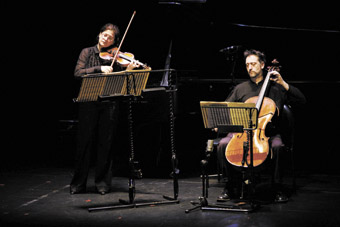contemporary…now and then
jon dale at adelaide’s contemporary music festival

Telesto Duo (Tiziana Pintus and John Addison) performing Constantine Koukias’ Byzantine Reflections
photo James Knowler
Telesto Duo (Tiziana Pintus and John Addison) performing Constantine Koukias’ Byzantine Reflections
BY EARLY APRIL, ADELAIDE WAS SHOWING SIGNS OF FESTIVAL EXHAUSTION. INDEED, LOCAL ART SPACE AND EXPERIMENTAL MUSIC VENUE GALLERY DE LA CATESSEN, HOSTING FOUR PERFORMANCES IN FIVE DAYS, A RARE FEAT FOR UNDERGROUND MUSIC IN THIS CITY, CHEEKILY ASKED IN THEIR PROMOTIONAL FLYER, “IS THIS A FESTIVAL TOO?” THOUGH OBVIOUSLY HUMOROUS, THAT GENTLE POKE IN THE ADELAIDE CONTEMPORARY MUSIC FESTIVAL’S DIRECTION CUT TO THE QUICK: THE ACMF PROGRAM FELT BOTH SAFE AND ARBITRARY, ITS NAMING QUESTIONABLE.
Debates over genre are rife within this field. From contemporary through experimental, avant-garde, new music and so on, the ownership function of these concepts is connected more to overarching institutional frameworks—conservatoriums, funding bodies and so on who require a shorthand to codify the output of composers—than wider and less institutionally dictated discursive practices in what constitutes ‘the contemporary.’ Thus, the taxonomical anxiety at the heart of ACMF manifested directly in the festival’s program, with Russian composer Alfred Schnittke’s Piano Quintet (1972-76), in particular, almost voluptuously romantic.
The sentimentality of this quintet is doubtless due, at least in part, to its dedication to the composer’s mother, but Schnittke’s romanticism nonetheless stuck in the craw in the context of a ‘new music’ festival. Having said this, the quintet was still the most enjoyable entry in the Gala Concert. But while the Grainger Quartet have great facility to their vantage, their delivery across the program felt hermetic and uptight. One wonders how much this has to do with the relative conservatism of the program: with wilder, more open works perhaps the quartet could excel. As it was, pieces such as English-Australian polymath Andrew Ford’s A Reel, A Fling And A Ghostly Gallard: String Quartet no 2 (2006)—whose opening pauses promised plenty, only to give way to ‘celebratory dances’ that lacked exuberance or fire—didn’t offer enough challenge to these capable players.
The Telestos Duo of Tiziana Pintus (violin) and John Addison (cello) were more generous in their performances, though their material at the Gala Concert left them wanting. English-Australian composer Tristram Cary’s Messages For Solo ‘Cello (1993) featured some passages that were quite evocative, but overall the composition is too starchy, and while Addison performed strongly, the material offered little freedom to move. Indeed, the late Cary’s great contribution to modern music lies in his pioneering electronic work. At the ACMF’s second day of programming, held at the Festival Centre Artspace, soprano Greta Bradman performed his I Am Here (1980). Bradman possesses a fine voice, but the spray of phonemes created by Cary collaborator Peter Zinovieff’s text, coupled with the overworked performativity in Bradman’s delivery, fought against the tape accompaniment. The tape elements also needed to more clearly work the grain and texture of the tape into the compositional outcome. As it was, this sound source favoured the logic of process over the tactility of outcome.
I Am Here was preceded by a festival highlight: the Telesto Duo’s breathtaking performance of Russian composer Sofia Gubaidulina’s sonata for violin and cello, Rejoice! (1981/88). While Gubaidulina’s compositions are sometimes played with too much emotive flair, which leads to performances that link the spirituality and ‘profundity’ of her compositions to overtly ‘deep’ gestures, Telesto Duo approached Rejoice! with the right amount of studiousness. Particularly affecting was a series of harmonics, quietly wrung from the violin by Tiziana Pintus, which held the collective breath of the Artspace audience and briefly transformed the space’s antiseptic vibe into an ennobled zone—reflective and smart, without any recourse to pious display.
ACMF’s problem lies in the ambivalence it engenders in any critical member of the audience; the festival feels too benumbed to have any interventionist impact. While it glances toward electronic/tape music, its too slight acknowledgement of prepared or extended technique and its seeming ignorance of improvisation—two of the most significant leaps made by classical music in the 20th century—leaves one wondering which decade the contemporary in the title refers to. This may seem rather harsh criticism, and Gabriella Smart certainly deserves a tip of the hat for organising an event that leads one to ask these questions. But if new music or contemporary music (or whatever turn-of-phrase you use to box it in) is to make significant advances, festivals like ACMF need to pull off their blinders.
Adelaide Contemporary Music Festival, Adelaide Festival Centre, April 4-6
RealTime issue #85 June-July 2008 pg. 50






